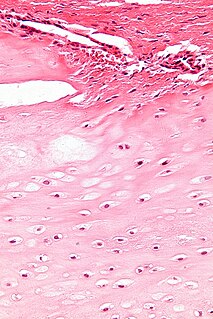Related Research Articles

A bifid rib is a congenital abnormality of the rib cage and associated muscles and nerves which occurs in about 1.2% of humans. Bifid ribs occur in up to 8.4% of Samoans. The sternal end of the rib is cleaved into two. It is usually unilateral.

An exanthem is a widespread rash occurring on the outside of the body and usually occurring in children. An exanthem can be caused by toxins, drugs, or microorganisms, or can result from autoimmune disease.

Multiple endocrine neoplasia type 2 is a group of medical disorders associated with tumors of the endocrine system. The tumors may be benign or malignant (cancer). They generally occur in endocrine organs, but may also occur in endocrine tissues of organs not classically thought of as endocrine.

The lateral cutaneous nerve of the thigh is a cutaneous nerve that innervates the skin on the lateral part of the thigh.

Maffucci syndrome is a very rare disorder in which multiple benign tumors of cartilage develop within the bones. The tumors most commonly appear in the bones of the hands, feet, and limbs, causing bone deformities and short limbs.

Juvenile xanthogranuloma is a form of histiocytosis, classified as "non-Langerhans cell histiocytosis", or more specifically, "type 2".
Unilateral nevoid telangiectasia presents with fine, threadlike telangiectases, developing in a unilateral, sometimes dermatomal, distribution, with the areas most often involved being the trigeminal and C3 and C4 or adjacent areas.
Congenital onychodysplasia of the index fingers is defined by the presence of the condition at birth, either unilateral or bilateral index finger involvement, variable distortion of the nail or lunula, and polyonychia, micronychia, anonychia, hemionychogryphosis, or malalignment.
Alezzandrini syndrome is a very rare syndrome characterized by a unilateral degenerative retinitis, followed after several months by ipsilateral vitiligo on the face and ipsilateral poliosis. Deafness may also be present.
Incontinentia pigmenti achromians is a cutaneous condition characterized by various patterns of bilateral or unilateral hypopigmentation following the lines of Blaschko. Though the consistency of the skin findings have led to the term "hypomelanosis of Ito", it actually refers to a group of disorders with various genetic causes including polyploidies and aneuploidies. Based upon the specifics of the genetic defect, the skin findings can be accompanied by a great range of systemic findings. These include central nervous system, ocular, and musculoskeletal defects. Nonetheless, the vast majority of cases are limited to the skin. As opposed to incontinentia pigmenti, hypomelanosis of Ito affects both genders equally. This disorder was first described by Japanese dermatologist Minor Ito in 1952.

Lichen striatus is a rare skin condition that is seen primarily in children, most frequently appearing ages 5–15. It consists of a self-limiting eruption of small, scaly papules.
Asymmetric periflexural exanthem of childhood (APEC) is a rare, self-limited and spontaneously resolving skin rash of the exanthem type with unknown cause that occurs in children. It occurs primarily in the late winter and early spring, most common in Europe, and affecting girls more often than boys.
Partial unilateral lentiginosis is a cutaneous condition characterized by lentigines located on only one half of the body.
A urethral caruncle is a benign cutaneous condition characterized by distal urethral lesions that are most commonly found in post-menopausal women. They appear red, and can be various sizes. They can have the appearance of a tumor. These epidermal growths are found around the posterior portion of the urethral meatus. They can bleed and occasionally cause dysuria and dyspareunia. The caruncles can be removed by surgery, electric cauterization and then with suture repair. Pathology studies are necessary to distinguish carcinoma of the urethra from urethral caruncles. Caruncles can grow back in some instances. Urethral caruncles can accompany the skin changes related to lowered estrogen levels. They can become a source of chronic hematuria, infection, and urethritis.

A pigmented spindle cell nevus is a skin condition characterized by a dark brown to black macule or papule, usually less than 6 mm.

Favre–Racouchot syndrome is a solar elastotic disorder consisting of multiple open comedones that occurs in skin damaged by sunlight, especially under and lateral of the eyes. The comedones are widened openings for hair follicles and sebaceous glands filled with material.
Rosenthal–Kloepfer syndrome, is a cutaneous condition characterized by abnormal growth of bone and skin, coupled with clouding of the cornea. It was described in 1962. Another name for the condition is Acromegaly-cutis verticis gyrata-corneal leukoma syndrome.
Linear atrophoderma of Moulin is an acquired unilateral dermatitis localized along the Blaschko lines. It affects children or adolescents of both genders, involving the trunk and the limbs. It is, presumably, a rare cutaneous form of mosaicism. This disease was first referred to as Atrophoderma of Moulin after Dr.Moulin who first reported it in 1992 then was renamed as linear atrophoderma of Moulin. Only a few dozen cases have been described; for this reason, LAM is considered to be a very rare disorder.
Microphthalmia–dermal aplasia–sclerocornea syndrome is a condition characterized by linear skin lesions. MLS is a rare X-linked dominant male-lethal disease characterized by unilateral or bilateral microphthalmia and linear skin defects in affected females, and in utero lethality for affected males. It can be associated with HCCS, mutations in it cause microphthalmia with Linear Skin Defects Syndrome.
Garrod's pads are a cutaneous condition characterized by calluses on the dorsal aspect of the interphalangeal joints, i.e. the back side of the finger joints. They are often seen in violin, viola, and cello players, along with fiddler's neck and other dermatologic conditions peculiar to string musicians. Although Garrod's pads are conventionally described as appearing on the proximal interphalangeal joint, distal interphalangeal joint involvement has also been described.
References
- ↑ Rapini, Ronald P.; Bolognia, Jean L.; Jorizzo, Joseph L. (2007). Dermatology: 2-Volume Set. St. Louis: Mosby. pp. 848–9, 851. ISBN 1-4160-2999-0.